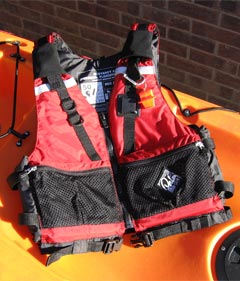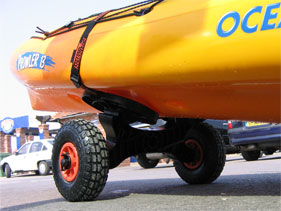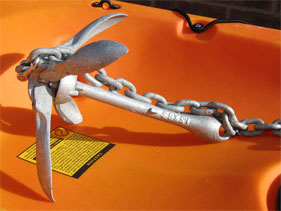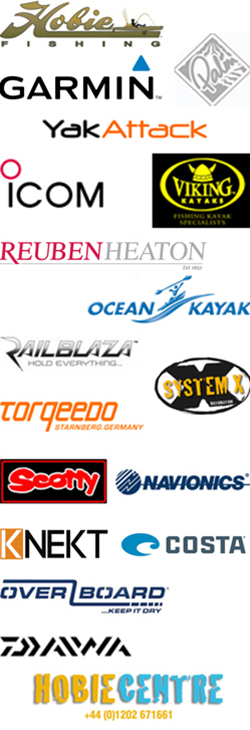Safety EquipmentKayak fishing is an extreme sport, when taking to the water in any craft you need to act responsibly and carry some very necessary safety.
PFD, Personal Flotation Device, this should be a good fit, most have shoulder and waist adjustment to enable you to pull tight and prevent it from riding up over your head should you enter the water unexpectedly, children's PFD's also include a strap or straps which go between the legs preventing the child from slipping out th bottom of the PFD.

PFD (Personal Floation Device).
When choosing a design, look for a zip entry for convenience with plenty of pockets, D-rings and reflective tape. It's worth considering the amount of bulk at the back of the PFD and where it sits in regard to your seat back, this can be an irritation should you get it wrong. Some PFD designs are very bulky around the tummy, making deep water self rescues difficult as the bulk can catch on the gunwales of the kayak. Check the buoyancy level of the jacket against your weight before purchasing.
On your PFD you should carry a few basic personal emergency items, a blunt tipped single sided blade rescue knife, a set of personal flares, a compass, whistle and VHF radio (minimum 5 watt output, 1 watt = approximately 1 mile line of sight). VHF's are an expensive item, but buy a quality one, kayak fishing is a harsh environment and you need to know that your radio will not give up after a few months use due to corrosion.
Other equipment worth carrying onboard are a First Aid Kit, Orange Smoke Flare (used to pinpoint your location once rescue services are in sight) space blanket, waterproof torch, and a sponge or container to use as a bailer should the kayak become flooded.
Suncream and protective glasses, you are very close to the water in a kayak, your skin and eyes will both need protection from the sun and reflective qualities of the sea.
If you are likely to be paddling in rivers or narrow tidal areas it would be a very good idea to carry a throw line for the safety of others or yourself.
With experience an anchor is also a useful piece of safety equipment, but not for beginners, we will come to that later.
Further safety reading.
Clothing
Cag with hood, PFD (Personal Floation Device), paddle pants and hard soled boots comfortable, warm and designed for kayaking. Items shown are ideal for summer and early autumn use.
There are two lines of thought here, some prefer the use a breathable drysuit with built in socks for all year round protection, they are not excessively expensive and some come with fleece one piece undergarments as standard, latex is used at the neck and wrists to prevent water entry, this can be an irritant to some skin types, especially after prolonged use.
The alternative is the two piece suit, cag breathable dry top and paddle pants, these can be of the bib and brace style with built in socks or a standard sock less trouser. Some cags come with latex neck and wrist seals others with a neoprene neck which is much kinder to the skin. Cags are also available with a built in hood which is a boon should the wind pick up or the rain poor down. Some cag and paddle pants are designed to lock together with a series of neoprene and Velcro layers which prevents leakage. The cag and paddle pants option is very flexible as you are able to remove layers according to weather conditions.
During the winter months thin wickable layers are worn beneath adding one or two thin fleeces for comfort.
Which ever style of clothing is chosen, ensure it has a built in fly, it can be along paddle home if not!
Boots, a hard bottomed boot is advised, many neoprene boots are designed for surfers and windsurfers, these have soft bottoms to allow the board to be felt under foot, hauling a kayak over larger pebbles with soft shoes is not a pleasant experience. Kayak, dingy and jet ski boots are all excellent choices.
|
|
AccessoriesIf your launch site requires even a short walk to the sea a trolley or kart will make transporting your kayak from the car so much easier, there are various types and styles, one of the more successful being the C-Tug.

Ocean Kayak's C-Tug.
It's possible to get carried away where accessories are concerned, it's always advisable to go out and paddle, followed by a little fishing in your new kayak before you should consider getting out the drill.
Rod holders are available with varying types of bases and to accommodate different styles of rods and reels, from the standard flush mounts which are fitted to many of the Angler editions of kayak to the more sophisticated twist lock holders.
Fishfinders. An important consideration is that the display unit is waterproof, some displays are even designed to float. Purchase the highest definition that you can afford, if your able go along to a chandlers and look at the displays in simulation mode this will give a good indication of the difference between models. Some makes are a little easier to fit to a kayak than others. Some of the Ocean Kayak models have a transducer scupper hole in their hull which is designed to accommodate a transducer boot accessory that is made specifically for Humminbird finders and transducers.
Some Fishfinders now come fitted with GPS in a very compact unit, not only a useful safety option, but also very useful when returning to a productive mark.
Safety Leashes, anything that is not tied to the kayak can and will be lost over the side, all rods and reels should be leashed to the kayak when not being held, items of value should also be leashed. Smaller items can be kept in a bag or box leashed in the tankwell.
There are three main methods of anchoring your kayak, the easiest method and one that should be used by beginners is using a metre of shockcord with a carabiner fitted to each end, one is clipped to the cockpit carrying handle and the other end to a pot buoy. This is one of the safer methods of anchoring, should you get into difficulty simply cut the shockcord or release the carabiner, return at a safer state of tide to pick up the carabiner. Find out how to make one.
Second method of anchoring is by using a sea anchor or drogue, used to slow the speed of drift, the angle of drift can be changed by clipping the drogue to your anchor trolley, this method can be very productive, especially when fly fishing.
Folding grapnel anchor, there are two weights used by kayak fishermen, the smaller 0.75kg which requires at least a meter of chain to work efficiently. The larger 1.5kg anchor is favoured in stronger tides, the chain is less necessary with this size anchor. Which ever size anchor is chosen, a weak link should be used, attach the main anchor via the bottom and add a weak link to the top of the anchor, should you become snared a hard tug to break the weak link could save the loss of the anchor. It's wise to carry a spare 0.75kg anchor as a back up. The anchor is also used in conjunction with an anchor trolley system.

0.75 kg Folding Grapnel Anchor with chain. Note chain fixed to bottom of anchor and weak link used at top to aid release should the anchor become snared.
An SMB (Small Marker Buoy) divers reel is used to hold the anchor line and keep it tidy, it also allows controlled deployment of the anchor, some prefer to make their own reel which allows the Anchor to be reeled in with easy.
Paddle PlanBefore setting out, tell somebody onshore where you intend to paddle and when you will return, call them on your return. If your plans change, be sure to inform your contact onshore. Alternatively call the coastguard before leaving the beach, explain what you are doing and where you will be fishing, then call again on your return.
And FinallyAnd possibly the most important, commonsense, check the tides and weather conditions before leaving the beach. The weather can change quickly at sea, keep your wits about you and watch for subtle changes in conditions, increase in swell, increase in wind strength and changes in direction. If you have any doubts about going out, don't, it's far better to look for an alternative sheltered location or to return home than put yours and other lives at risk. |
